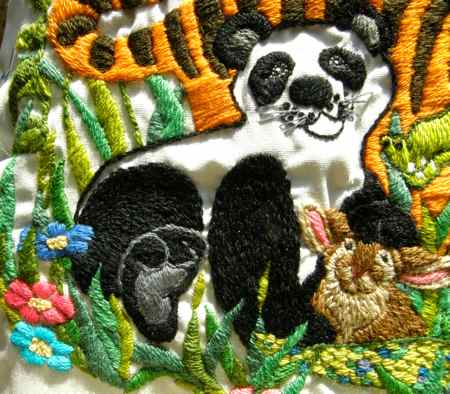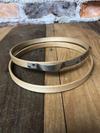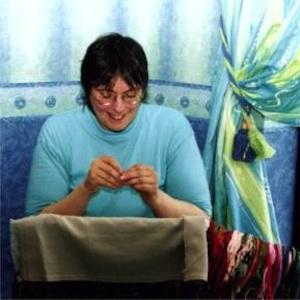- Home
- How-to-use-embroidery Hoops
How to Use Embroidery Hoops (photos and video)
Is there anything more frustrating than watching your stitches pull the fabric into puckers? It can ruin a great piece of work, but the good news is, it's fixable.
I’ll walk you through how to choose the right embroidery hoops, get that perfectly drum-tight tension, and even share a simple binding trick I use to stop puckers on delicate fabrics for good.
Quick takeaways
- Pick the right size: Use a hoop about 1–2 inches larger than your design area, it gives better tension and fewer edge puckers.
- Set tension like a drum: Tighten the screw, then gently pull fabric toward the inner hoop while tightening to keep cloth flat.
- Binding trick: Use a thin strip of calico or bias tape around the inside hoop for extra grip on slippery fabrics.
What Can Happen if You Don't Use a Hoop
I rediscovered an embroidery I stitched in my twenties and noticed the problem right away.
The fabric had puckered where I’d pulled stitches too tight, most noticeably around the panda’s white body and the narrow leaves on the left.
Using an embroidery hoop would have prevented those puckers by keeping the fabric taut and ensuring even tension. Now I hoop every project.

How to choose the right embroidery hoop
Quick answer: for most hand embroidery choose a 6-inch hoop. It’s the easiest size to control and fits most projects.
At a glance
- 5–6" - best for small motifs and fine detail.
- 6–8" - the sweet spot for most home projects (comfort + control)
- 8"+ or frame/stretcher - use for large pieces, wall hangings, or when you need a flat, stable surface.
Why size matters (the three factors)
Personal comfort
How well you can hold and rotate the hoop matters more than the number on the label. If you work standing or like to move the fabric a lot, a smaller hoop (5–6") gives better control. If you prefer to sit and rest your hands on the table, a larger hoop can feel more stable.
Stitching style
Dense satin stitches and heavy thread need more careful tension and sometimes more room; delicate surface embroidery or tiny backstitch work better in a smaller hoop so you can see and control the detail.
If you do lots of beading or metallic threads, avoid hooping directly over them. Use a big enough hoop so it doesn’t crush or snag the embellishments.
Project type
For small decorations, smaller hoops mean less wasted fabric.
For garments, a smaller hoop may fit better in between ready stitched seams.
Quilters should look for extra-deep hoops: the extra depth grips all three layers (top, batting, backing) securely and prevents slipping while you quilt.
For very large pieces, use a frame or stretcher bars instead of trying to hoop the whole thing.
Been-there tip
I usually reach for a 6" first — if the design is very small I drop to 5", and if I’m working a large sampler I swap to an 8" or a frame. That simple rule saves a lot of rehooping.
Workarounds for a big hoop
Hoop too large? Here’s a quick tip.
Use this method when you don’t have a smaller hoop handy.
- Lay a scrap of fabric (muslin or cotton) slightly larger than your embroidery piece, right side down.
- Place your embroidery fabric centered on top, right side up.
- Using a long running or basting stitch, sew through both layers around the outside edge (about ¼–½" from the edge) to join them. Keep stitches large enough so they’re easy to remove later.
- Put the fabric sandwich in your hoop, center the design, and tighten the hoop to the desired tension (not too tight)
- From the back, trim excess scrap fabric close to the hoop (leave a small margin to prevent fraying).
- After finishing the embroidery, snip the basting stitches and remove the scrap backing.
Tip: Try this on a small test piece first so you can adjust stitch size and tension.
How to tighten an embroidery hoop
Quick answer: use a good wooden hoop with an adjustable brass screw and tighten the fabric until it’s nicely taut (not stretched) with a drum-like sound when you flick it. That gives even, smooth stitches without puckering.
Why this matters: consistent tension keeps stitches flat and predictable, so your satin stitches won’t pull and your backstitch lines stay crisp.
How to get there (short, practical steps)
- Choose a quality wooden hoop with an adjustable brass screw. The screw is how you control tension.
- Hoop your fabric so it sits flat and centered.
- Tighten the screw a little, then gently pull the fabric at the edges to remove slack
- Flick the fabric — you want a short, drum-like “snap,” not a floppy thud.
- Check the fabric visually: it should be taut but not distorted or stretched thin. If stitches pull the fabric inward as you work, loosen slightly.
Keep a small flat-head screwdriver (or a coin) nearby so you can fine-tune tension without interrupting your flow.
Screw placement (keep it out of your way)
Positioning the screw properly prevents tangles and makes stitching more comfortable:
- Right-handed stitchers: place the screw at 10 o’clock.
- Left-handed stitchers: place the screw at 2 o’clock.
That keeps the screw behind your working hand and reduces snagging or thread wrapping.
Pro tip
Before starting your project, stitch a quick 2-inch test motif on a scrap hooped the same way. It’s the fastest way to confirm tension, screw position, and that your threads glide without catching.
How to stop your hoop slipping
Wrap the inside ring of your hoop with a thin, flexible strip (fine cotton, bias binding, or narrow ribbon) then tack it in place with a few small stitches.
The added friction keeps the fabric from sliding, so your tension stays steady and your stitches stay even. Don’t use anything bulky (it can distort tension); a narrow, tightly wrapped strip does the job best.
Binding the hoop - step-by-step
- Cut a ½"–¾" (13-19mm) strip of fine cotton, bias tape, or narrow ribbon long enough to wrap the inner ring.
- Start at one point and wrap the strip tightly and evenly around the inner hoop, overlapping slightly as you go so there are no gaps. Keep the wrapping flat; avoid bunching.
- Secure the end with 3–4 small, discreet running stitches through the strip and hoop (on the inside/back so they’re out of sight).
- Hoop your fabric and tighten as usual. Check tension — the fabric should sit taut, not pinched.
- If the strip shifts, add one more tiny stitch opposite the starting point to lock it in.
Pro tip
If your hoop still slips, try a narrower strip or add a second thin wrap for more grip, but never use thick padding that will change the hoop’s seating and distort the fabric.
Add a wrapped inner hoop to your toolkit and try it on a test square before you start your next project, you’ll notice fewer re-hooping interruptions.
Loosen the hoop between sessions
Always release the tension (or remove the hoop) when you stop stitching. Leaving a hoop tightened for long periods can leave permanent marks, distort fabric, and make finishing harder.
Why this helps:
- Prevents hoop marks and fabric creasing.
- Keeps fibers from stretching or becoming permanently distorted.
- Saves you time fixing problems later.
Simple Steps
- At the end of your session, loosen the brass screw until the fabric relaxes (or remove the hoop entirely).
- If you leave work in the hoop for short breaks, back the screw off slightly so the fabric isn’t held taut.
- Store projects flat or in a breathable bag to avoid pressure points.
Make releasing the hoop part of your "wrap up" routine as five seconds now avoids the frustration of hoop marks later.
Alternatives to traditional hoops
Wooden hoops are classic, but several modern options can make your life easier or change how your finished work looks.
Below are the most useful alternatives, what they’re good for, and one quick tip for deciding which to try first.
Flexi-hoops - neat for display and framing
Flexi-hoops use a rigid inner ring plus a flexible outer ring that snaps over the fabric.
They’re lightweight, give a clean, professional edge for finished pieces, and are great when you want to display work straight out of the hoop.
Pros: looks neat for finished pieces, low profile, portable
Cons: can be fiddly to assemble, which is not ideal if you have limited hand mobility or arthritis.
Tip: if you like the display look but struggle with assembly, try a Q-snap or ask a friend to help with the first fit.
Q-Snap frames - the best portable, on-the-go choice
Q-Snaps are plastic frames that click together to form a square or rectangle. They’re easy to store, quick to set up, and excellent when you want something light and portable.
Pros: modular shapes, lightweight, easy to pack.
Cons: they usually need more frequent tensioning than a hoop. Expect to tweak as you stitch.
Tip: use smaller frame sizes for detailed work; larger frames can be used for big projects but require more attention to keep tension even.
Spring hoops - designed for machine embroidery
Spring hoops are almost-flat rings with a spring action that lets them slip under a machine foot. They’re designed to work with machine embroidery setups and low-profile stitching.
Pros: works with machine embroidery, very flat.
Cons: the spring mechanism and handles can catch thread and take practice to manage.
Tip: practice once or twice with scrap fabric to learn how the spring behaves under your machine.
Which one should you try? (quick guide)
- Want a polished display without a frame? Try a flexi-hoop.
- Need light, portable, easy storage? Try a Q-Snap.
- Working with a machine? Try a spring hoop (test on scrap first).
Frequently Asked Questions (FAQ)
What size embroidery hoop should I start with?
What size embroidery hoop should I start with?
Start with a 4–6 inch hoop for most beginner projects — small hoops are easier to handle and keep fabric taut.
How tight should an embroidery hoop be?
How tight should an embroidery hoop be?
Tight enough that the fabric sounds and feels like a drum when tapped — not so tight the fabric distorts stitches.
What’s the best way to stop fabric from slipping?
What’s the best way to stop fabric from slipping?
Use a binding strip (twill tape or masking tape) around the inner ring or place a small rubber washer under the screw for extra grip.
Should I hoop my fabric before or after washing?
Should I hoop my fabric before or after washing?
Pre-wash if the fabric will shrink or bleed. Hoop it after it’s fully dry and pressed to maintain accurate tension and design placement.
Is there a difference between wooden and plastic hoops?
Is there a difference between wooden and plastic hoops?
Wooden hoops give a traditional feel and slightly more grip; plastic hoops are lightweight and often cheaper; choose by comfort and the project’s needs.
Can left-handed stitchers use a hoop easily?
Can left-handed stitchers use a hoop easily?
Yes, orient the hoop screw to the top or right/left depending on comfort (showing both orientations in your images helps left-handers)
Do you have other questions about embroidery hoops?
Which type do you prefer? When do you use them, and when don't you? Feel free to ask questions, or answer other people's queries.
This is your section of the page, so feel free to add anything that you think will help other embroiderers find out which are the right hoops for them.
What Other Visitors Have Said
Click below to see contributions from other visitors to this page...
Fabric size vs design size vs hoop size 




I am doing a project on 8 inch fabric. The design is a 6 inch and I want to use a 4 inch hoop. Is that OK?
Sprung hoops 




I'm searching for sprung hoops. I hadn't realised how rare and unusual they were, until after I lost my grandmother's beautiful 8" Princess hoop.
After …
When were embroidery hoops invented? 




I'm watching a show on Edwardians and the ladies were stitching without hoops. I was wondering when hoops were invented. I would have assumed a long time …
Do spring hoops leave marks? 




My granddaughter and husband are having trouble with hoops marks on their work. It seems to be coming from the metal part of the spring hoop. I remind …
Spring hoops, I like them 




I like spring hoops because of the tension.
I always put the hoop on a flat surface place the front of the fabric facing me because after I place the …
Making the fabric taut 




I am starting on my second cross stitch project. The first one I never finished because it was looking so bad.
What I am having a problem with is getting …
needlework frames that keep the fabric taut 



Is there any scroll frame that holds the sides of the fabric?
I find that with a scroll frame, while the fabric can be tight, it always sags on the …
Will putting a hoop over my work damage it Not rated yet
I have returned to doing cross stitching from years ago and never used a hoop or frame. But now I am, and like it feel my work is neater.
However, …
Wood embroidery hoops Not rated yet
What kind of wood are embroidery hoops made from? I am embroidering a large tablecloth as a keepsake. What size hoop is optimal? Help please!
Carol …
Stay connected between projects
If you’d like occasional updates from my embroidery room, including new patterns, gentle tips, and little things I think you might enjoy, you’re warmly invited to join the Stitchin’ Times newsletter.
No pressure. Just a friendly note now and then to keep you inspired.








